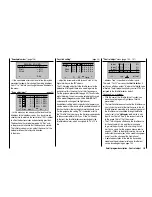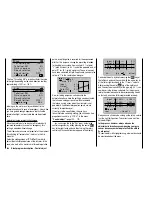
278
Detail program description - Control adjust
Basic procedure:
Move the C1 joystick and, along with it, the vertical
•
line in the graphic display toward idle to -50 % control
travel and briefl y press the central
SET
key of the
right touch pad.
In order to attain the curve shape shown, raise
•
this point with the arrow keys to approx. 0 % in the
inverse value fi eld of the "Point" line.
Then round the characteristic curve by moving the
•
marking frame up to the "Curve" line, briefl y pressing
the central
SET
key of the right touch pad and then
changing the value from "Off" to "On" with the arrow
keys.
If additional interpolation points between the left ("L")
and right ("H") end are necessary, repeat Steps 2 and 3
analogously.
Since F3A models normally have two aileron servos,
experience has shown that it is benefi cial to move
both ailerons upward
somewhat
when landing. In the
process, the model usually fl ies somewhat slower and,
fi rst and foremost,
more steadily
for the landing. For this
reason, it is necessary to program mixers through the
menu ...
"Free mixers"
(page 181)
... accordingly.
The ailerons are extended as landing assistance
depending on the position of the throttle stick, starting
from approximately half throttle toward idle. The
further the joystick is moved toward idle, the more the
ailerons defl ect upward. Just the opposite applies when
"throttling"; the ailerons are retracted again in order to
prevent a sudden rise of the model.
In order to prevent the model from climbing with the
aileron landing fl aps extended, the elevator must be
mixed in somewhat.
For this purpose, set the two linear mixers shown in
the following display. The activation of the mixers takes
place with one and the same switch, such as SW 8,
to which both mixers must be assigned with identical
switching direction.
ty
fr
to
M1
M2
M3
C1
5
C1
EL
M4
M5
??
??
??
??
??
??
8
8
Then switch to the second respective display screen in
order to adjust the respective mixing degrees. In both
cases the mixer neutral point is at the C1 control center.
Enter 0 % above the control center after selection of the
ASY
fi eld for both mixers and below the control center
toward idle for:
MIX 1:
-60 % ... -80 % and
MIX 2:
-5 % ... -10 % .
Example L.MIX 1:
0%
0%
0%
FLAP
nor mal
0%
0%
0%
FL
fl.pos
EL
FL
Diff.
With this, the base setup model of an F3A model is
concluded.
Compensation of model-specifi c errors
Unfortunately, there are nearly always minor model-
specifi c "errors" through the mixers of a computer
remote control which must be compensated for.
However, before you begin with these settings, it should
be ensured that the model is faultlessly constructed,
optimally balanced over the longitudinal and transverse
axes and the down thrust and side thrust are correct.
Infl uence of longitudinal and transverse axes by the
rudder
The actuation of the rudder often infl uences the
behavior of the longitudinal and transverse axes. This
is particularly disruptive in so-called knife-edge fl ying,
in which the lift of the model with the rudder defl ected
should be created by the fuselage alone. In the process,
the model can rotate and change directions as though it
were controlled with the ailerons and elevator. Therefore,
a correction over the transverse axis (elevator) and/
or the longitudinal axis (ailerons) must be made, if
applicable.
This can also be carried out with the "
Free mixers
"
of
mx-20
HoTT. If, for example, the model rotates
away to the right over the longitudinal axis with the
rudder extended in knife-edge fl ying, the aileron can be
defl ected to the left with the mixer. Changes in direction
over the transverse axis can be performed analogously
with a mixer on the elevator:
Correction over the transverse axis (elevator)
•
L.Mix 3: "Rudd
Elev"
Asymmetric setting. The appropriate values must be
tested in fl ight.
Correction over the longitudinal axis (aileron)
•
L.Mix 4: "Rudd
AIL"
Summary of Contents for mx-20 Hott
Page 41: ...41 Your notes...
Page 49: ...49 Your notes...
Page 55: ...55 Your notes...
Page 81: ...81 Your notes...
Page 85: ...85 Your notes...
Page 89: ...89 Your notes...
Page 99: ...99 Detail program description Control adjust...
Page 127: ...127 Detail program description Control adjust...
Page 131: ...131 Detail program description Control adjust...
Page 163: ...163 Detail program description Control adjust...
Page 191: ...191 Detail program description Control adjust...
Page 207: ...207 Detail program description Control adjust...
Page 228: ...228 Detail program description Control adjust...
Page 229: ...229 Detail program description Control adjust...
Page 251: ...251 Detail program description Control adjust...
















































